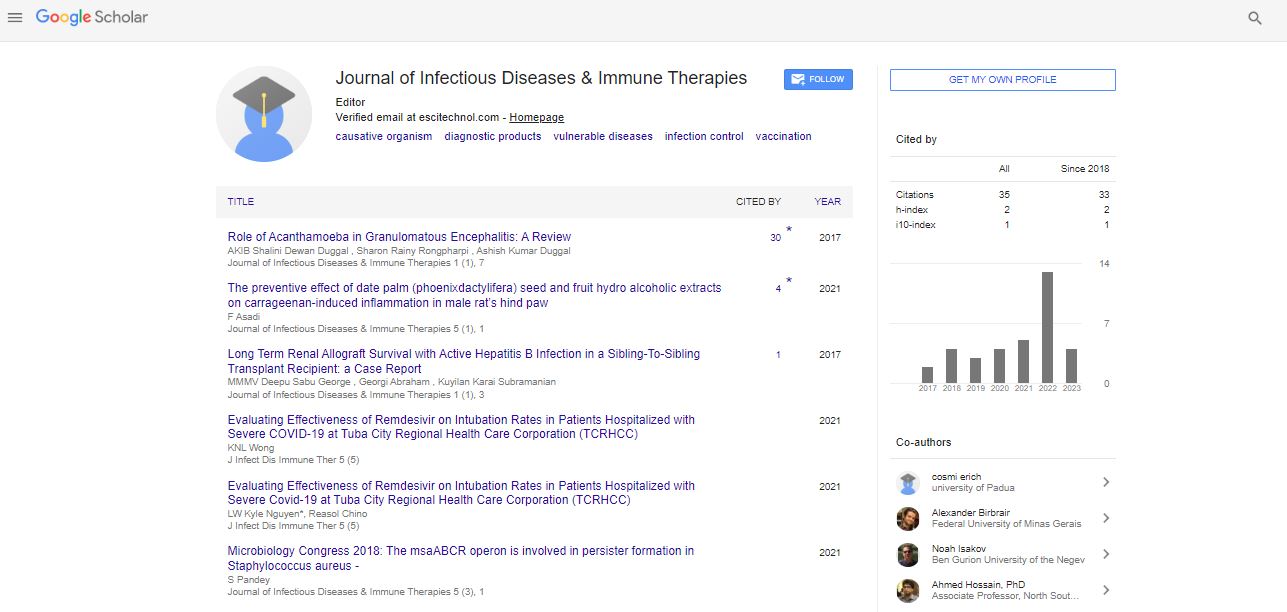Commentary, Vol: 12 Issue: 2
Mycotic Infections: An Overview of Diagnosis, Treatment and Prevention
Lisheng Wang*
Department of Molecular Physiology and Biophysics, Vanderbilt University, Nashville, TN, USA
*Corresponding Author: Lisheng Wang
Department of Molecular Physiology and
Biophysics, Vanderbilt University, Nashville, TN, USA
E-mail: lishengwang@.edu.cn
Received date: 27 May, 2023, Manuscript No. JIDITH-23-106352;
Editor assigned date: 29 May, 2023, Pre QC No. JIDITH-23-106352 (PQ);
Reviewed date: 15 June, 2023, QC No. JIDITH-23-106352;
Revised date: 23 June, 2023, Manuscript No. JIDITH-23-106352(R);
Published date: 30 June, 2023, DOI: 10.4172/2329-9541.1000341
Citation: Wang L (2023) Mycotic Infections: An Overview of Diagnosis, Treatment and Prevention. J Immunol Tech Infect Dis 12:2.
Description
Mycotic infections, caused by pathogenic fungi, are a significant global health concern, affecting individuals across all age groups and geographic regions. This provides a comprehensive overview of mycotic infections, including their epidemiology, pathogenesis, clinical manifestations, diagnostic approaches, treatment options, and preventive measures. Understanding the intricacies of these infections is crucial for healthcare professionals in order to ensure timely and appropriate management, reducing morbidity and mortality associated with mycotic infections.
Mycotic infections, also known as fungal infections, are caused by various species of pathogenic fungi. They can affect different parts of the body, including the skin, nails, respiratory system, gastrointestinal tract, and bloodstream. With the increasing prevalence of immunocompromised individuals and global travel, mycotic infections have become a significant public health issue. This aims to provide a comprehensive overview of mycotic infections, highlighting their diagnosis, treatment, and preventive strategies.
Mycotic infections have a global distribution and can affect individuals of all ages. Factors such as geographical location, climate, socioeconomic status, and immunological status contribute to variations in the incidence and prevalence of mycotic infections. Fungal pathogens may be acquired through direct contact with contaminated environments or through the inhalation of spores. Certain high-risk populations, including those with weakened immune systems, diabetes mellitus, or exposure to specific occupational or recreational activities, are particularly susceptible to these infections.
Pathogenic fungi possess several virulence factors that enable them to invade and colonize host tissues, leading to disease manifestation. The clinical presentation of mycotic infections varies widely depending on the site of infection and the host's immune response. Superficial infections typically affect the skin and nails, causing conditions like dermatophytosis and onychomycosis. Deep-seated infections can involve the respiratory system such as aspergillosis and cryptococcosis, the gastrointestinal tract such as candidiasis, or the bloodstream such as candidemia.
Accurate diagnosis of mycotic infections relies on a combination of clinical evaluation, microbiological tests, and imaging studies. Microscopic examination of stained samples, culture techniques, antigen detection assays, molecular diagnostics, and serological tests are commonly employed to identify the causative fungi. In certain cases, invasive procedures such as biopsies may be necessary to obtain tissue samples for histopathological examination.
The management of mycotic infections often involves a combination of antifungal therapy, surgical interventions, and supportive care. The choice of antifungal agents depends on the specific fungal species, site of infection, and the patient's immune status. Azoles, polyenes, echinocandins, and allylamines are among the classes of antifungal drugs utilized. In severe or systemic infections, intravenous therapy is usually preferred, while milder infections may be managed with topical or oral antifungal agents. Surgical intervention may be necessary in cases of localized or refractory infections.
Preventing mycotic infections involves implementing strategies to reduce exposure to fungal pathogens. This includes maintaining good personal hygiene, practicing infection control measures in healthcare settings, ensuring proper ventilation in buildings, and avoiding environments conducive to fungal growth. Vaccines against certain fungal pathogens, such as Histoplasma and Candida, are currently under development and may offer additional preventive measures in the future. Timely diagnosis and treatment of underlying conditions, such as diabetes or immunosuppression, can also help reduce the risk of mycotic infections.
Mycotic infections pose a significant healthcare burden worldwide. This provides an overview of the epidemiology, pathogenesis, clinical manifestations, diagnosis, treatment, and preventive strategies for mycotic infections. Healthcare professionals need to be aware of these infections, as early diagnosis and appropriate management are vital to improving patient outcomes and reducing the associated morbidity and mortality. Ongoing research efforts and public health initiatives are essential in tackling the growing challenge of mycotic infections and ensuring the well-being of affected individuals.
 Spanish
Spanish  Chinese
Chinese  Russian
Russian  German
German  French
French  Japanese
Japanese  Portuguese
Portuguese  Hindi
Hindi 